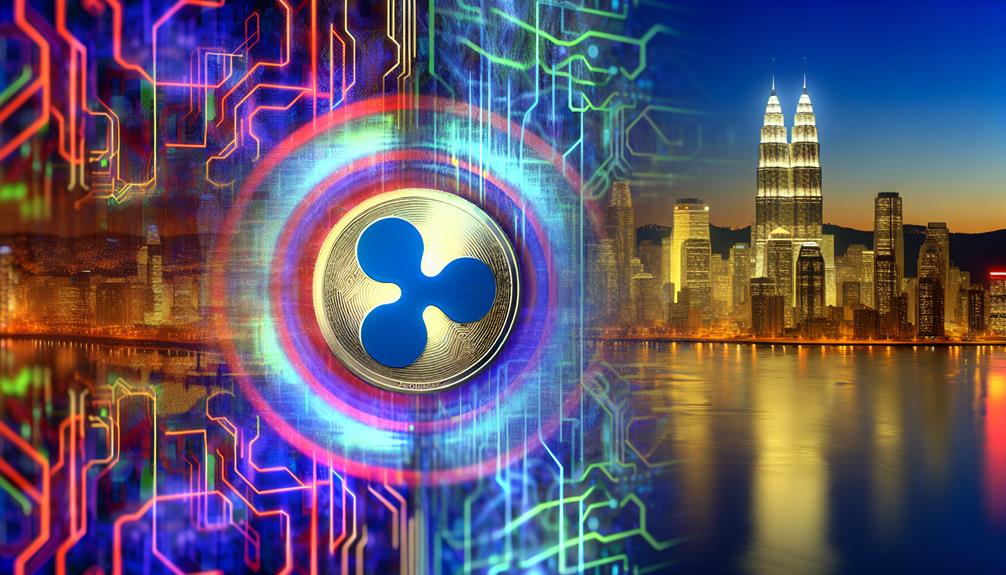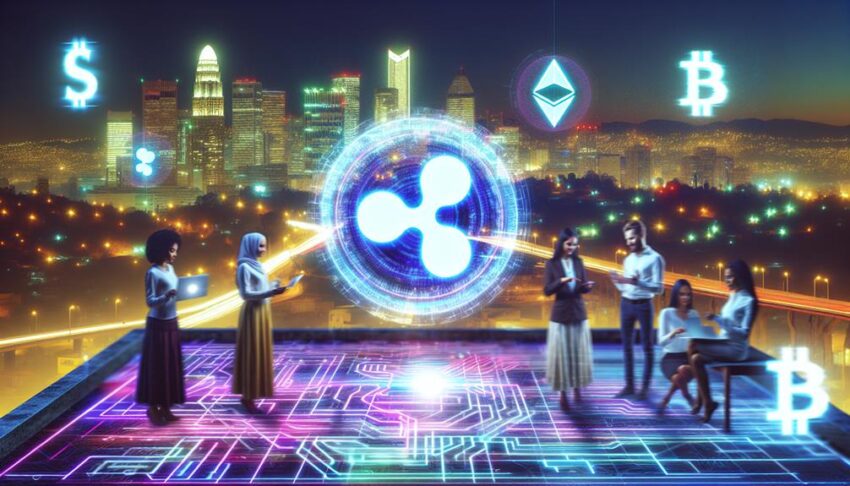Did you know that XRP can process transactions in just 3-5 seconds, compared to Bitcoin's 10 minutes? This efficiency positions XRP as a compelling alternative for cross-border payments, particularly among financial institutions. However, while its technological advantages are clear, there are significant hurdles, such as regulatory scrutiny and market perception, that could determine its future. What remains uncertain is whether these factors will ultimately hinder XRP's ambitions or pave the way for it to rise alongside Bitcoin in the cryptocurrency landscape.
Overview of XRP and Bitcoin

When you compare XRP and Bitcoin, you'll find that they serve distinct purposes within the cryptocurrency ecosystem. Bitcoin, launched in 2009, is primarily recognized as a store of value and a digital currency, aiming to provide a decentralized alternative to traditional currencies. Its scalability, however, has been a significant concern. The Bitcoin network can process only a limited number of transactions per second, leading to slower transaction times and higher fees during peak usage. This constraint has driven discussions about its viability for everyday transactions.
On the other hand, XRP, introduced by Ripple in 2012, is designed with specific XRP use cases in mind, particularly focused on facilitating fast and cost-effective cross-border payments. Unlike Bitcoin, XRP transactions are processed in mere seconds, making it an appealing option for financial institutions looking to improve their payment systems. This efficiency positions XRP as a practical solution for remittances and international transfers, where speed and low costs are paramount.
While Bitcoin continues to dominate the market as the first and most recognized cryptocurrency, its scalability issues have led to the emergence of alternative digital assets like XRP. These alternatives aim to address specific challenges within the financial landscape. As you explore the future of cryptocurrencies, understanding these distinctions between XRP and Bitcoin will be vital in evaluating their potential roles in an evolving digital economy.
Technology Comparison
Often overlooked in discussions about cryptocurrency, the underlying technologies of XRP and Bitcoin reveal significant differences that impact their functionality and use cases. At the core of these differences is the consensus mechanism each employs. Bitcoin utilizes a proof-of-work system, which requires substantial computational power and energy consumption. This approach can lead to slower transaction speeds, often taking several minutes to confirm a transaction. In contrast, XRP uses a unique consensus protocol that enables quicker transaction validations, typically within seconds, making it more suitable for real-time payments and financial transactions.
When it comes to scalability solutions, XRP has a clear advantage. Its architecture allows for thousands of transactions per second, addressing one of the major criticisms of Bitcoin's limited throughput. This scalability is vital for large-scale adoption, especially in sectors like banking and international remittances where speed and efficiency are paramount.
Energy efficiency is another important factor. Bitcoin's mining process is energy-intensive and often criticized for its environmental impact. XRP's consensus mechanism, however, operates with a fraction of the energy, making it more sustainable in the long run.
Market Trends and Adoption

The cryptocurrency market is witnessing a shift as investors and institutions increasingly consider XRP alongside established players like Bitcoin. This growing XRP adoption is reflected in various market trends, demonstrating its potential to capture a larger share of institutional interest. With the rise of digital assets, you've likely observed how market volatility is affecting trading strategies and investor sentiment.
To understand the current landscape, let's break down key factors influencing XRP's adoption:
| Factor | Description | Impact on XRP |
|---|---|---|
| Use Cases | Ripple's focus on cross-border payments enhances utility. | Increased adoption potential. |
| Institutional Interest | Major financial institutions exploring XRP for liquidity solutions. | Boosts credibility and trust. |
| Community Engagement | Active community supporting development and awareness. | Strengthens market position. |
| Liquidity Analysis | High liquidity enables easier transactions and investment. | Attracts more investors. |
As you analyze these factors, it's clear that XRP's positioning is becoming more robust. The community engagement around XRP indicates a strong foundation for future growth. Furthermore, with the ongoing liquidity analysis, XRP is proving to be an attractive option for traders seeking stability amidst market volatility. By adopting strategic trading approaches and keeping an eye on evolving trends, you can better navigate the changing landscape of cryptocurrency and potentially capitalize on XRP's upward trajectory.
Regulatory Challenges
Steering through the complex landscape of regulatory challenges is essential for XRP's future as it seeks to establish itself alongside Bitcoin. The ongoing XRP litigation has created significant market uncertainties, leaving investors and stakeholders in a state of apprehension. The outcome of this legal battle not only impacts XRP's value but also influences the broader perception of cryptocurrencies as a whole.
One of the primary obstacles XRP faces is the need for regulatory clarity. Without clear guidelines, companies and individuals may be hesitant to adopt or invest in XRP, fearing potential repercussions from regulators. This lack of clarity contributes to compliance hurdles that hinder XRP's growth potential. Companies looking to engage with XRP must navigate a maze of regulations, which can differ widely across jurisdictions.
Moreover, the evolving nature of cryptocurrency regulations adds another layer of complexity. As governments around the world develop and refine their approaches to digital assets, XRP must adapt to remain compliant. This fluid regulatory environment creates additional market uncertainties, making it challenging for XRP to attract long-term investments.
Future Predictions for XRP

Many analysts predict a cautiously optimistic future for XRP, especially as regulatory clarity begins to emerge. This shift could provide a solid foundation for the token's price stability and growth potential. As businesses increasingly adopt XRP for its swift transaction capabilities, the range of XRP use cases is likely to expand. You might see more financial institutions leveraging XRP for cross-border payments, enhancing its appeal in the global financial landscape.
XRP partnerships will play an essential role in this evolution. Ripple, the company behind XRP, has forged numerous alliances with banks and payment providers, which may lead to increased adoption and utility. As these partnerships grow, you could witness a network effect where greater use of XRP encourages more entities to join the ecosystem.
When considering XRP investment strategies, it's important to stay informed about market trends and regulatory developments. Analyzing XRP's historical performance alongside broader market movements can help you make more informed decisions.
Furthermore, the XRP community growth is another factor that can't be overlooked. A passionate and engaged community can drive awareness and usage, which may enhance the value proposition of XRP over time. As more individuals and institutions recognize the benefits of XRP, you might find increased demand that could positively influence its market price.
Frequently Asked Questions
What Distinguishes Xrp's Use Case From Bitcoin's?
XRP's utility focuses on facilitating cross-border payments, while Bitcoin serves primarily as digital gold. Market adoption, regulatory environment, and network scalability differentiate them, with XRP aiming for real-time transactions and liquidity in financial markets.
How Does Xrp's Transaction Speed Compare to Bitcoin's?
When you compare transaction speeds, XRP's scalability advantages shine through. With faster processing times and lower transaction cost efficiency, XRP can handle more transactions per second than Bitcoin, making it a compelling alternative for many users.
Can XRP Be Mined Like Bitcoin?
You can't mine XRP like Bitcoin. Ripple technology uses a consensus protocol instead of mining, allowing transactions to be processed quickly and efficiently. This design promotes scalability and energy efficiency, distinguishing XRP's model from traditional mining methods.
What Are Common Misconceptions About Xrp?
Many think XRP's solely for speculation, but it's actually aimed at facilitating cross-border transactions. Misunderstandings about XRP regulations and its adoption often lead to confusion, as its true utility gets overshadowed by market volatility.
How Does Xrp's Community Engagement Differ From Bitcoin's?
XRP's community engagement emphasizes adoption through targeted initiatives and active social media presence. Unlike Bitcoin, it prioritizes user feedback and advocacy efforts, fostering collaboration to enhance its ecosystem and drive broader acceptance among potential users.
Conclusion
To sum up, while some may argue XRP can't match Bitcoin's prominence, it's crucial to recognize its unique advantages in cross-border payments and efficiency. As financial institutions increasingly seek alternatives to traditional methods, XRP's potential for adoption grows. If it successfully navigates regulatory challenges, it could carve out a significant niche in the cryptocurrency landscape. Consequently, XRP's journey may not replicate Bitcoin's, but it definitely has the potential to redefine the future of digital payments.
